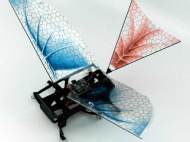Wing-assisted running robot DASH+Wings offers implications for avian flight evolution
 Remaining stable while going over obstacles is fairly tricky for small robots, so the researchers at the University of California, Berkeley, fixed a small robot dubbed DASH (Dynamic Autonomous Sprawled Hexapod) with lateral and tail wings borrowed from a store-bought toy to see if that would help. Although the wings haven’t enabled the robot to actually fly, they have increased its other capabilities.
Remaining stable while going over obstacles is fairly tricky for small robots, so the researchers at the University of California, Berkeley, fixed a small robot dubbed DASH (Dynamic Autonomous Sprawled Hexapod) with lateral and tail wings borrowed from a store-bought toy to see if that would help. Although the wings haven’t enabled the robot to actually fly, they have increased its other capabilities.
“Our overall goal is to give our robots the same all-terrain capabilities that other animals have”, said lead researcher Ron Fearing, professor of electrical engineering and head of the Biomimetic Millisystems Lab at UC Berkeley. “In the real world, there will be situations where flying is a better option than crawling, and other places where flying won’t work, such as in confined or crowded spaces. We needed a hybrid running-and-flying robot.”
With only 10cm (4 inches) in length, DASH is a lightweight and fast robot made of inexpensive, off-the-shelf materials, including compliant fiber board with legs driven by a battery-powered motor. The UC Berkeley research team came up with 4 different configurations of the robotic roach and named them DASH+Wings. The test robots included one with a tail only and another that just had the wing’s frames, to determine how the wings impacted robot’s movement.
They found that the extra boost would not have generated enough speed to launch the critter from the ground. The wing flapping also enhanced the aerial performance of the robot, consistent with the hypothesis that flight originated in gliding tree-dwellers.
DASH+Wings running speed is nearly doubled compared to DASH (from 0.68 m/s with legs alone to 1.29 m/s with additional wings). The robot could also take on steeper hills, going from an incline angle of 5.6 degrees to 16.9 degrees. The flapping wings improved the lift-drag ratio which helps the DASH+Wings to land on its feet and continue on its way. Wind tunnel experiments showed that it is aerodynamically capable of gliding at an angle up to 24.7 degrees.
The engineering team’s work caught the attention of animal flight expert Robert Dudley, a UC Berkeley professor of integrative biology, who referenced that previous computer models suggest that ground-dwellers, given the right conditions, would need only to triple their running speed in order to build up enough thrust for takeoff. The fact that DASH+Wings could realize a doubling of its running speed suggests that wings do not provide enough of a boost to launch an animal from the ground.
Dudley is interested in this research because it could provide data which would explain how flight evolved. He added that the winged version of DASH is not a perfect model for proto-birds – it has six legs instead of two, and its wings use a sheet of plastic rather than feathers – and thus cannot provide a definitive answer about flight evolution.
“What the experiments did do was to demonstrate the feasibility of using robot models to test hypotheses of flight origins”, said Dudley. “It’s the proof of concept that we can actually learn something useful about biological performance through systematic testing of a physical model.”
For more information about the research, read the article published in the peer-reviewed journal Bioinspiration and Biomimetics named: “A wing-assisted running robot and implications for avian flight evolution ports its conclusions online”.









Leave your response!